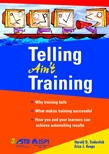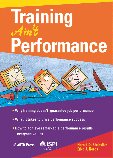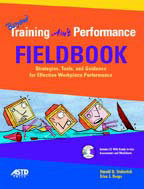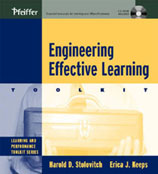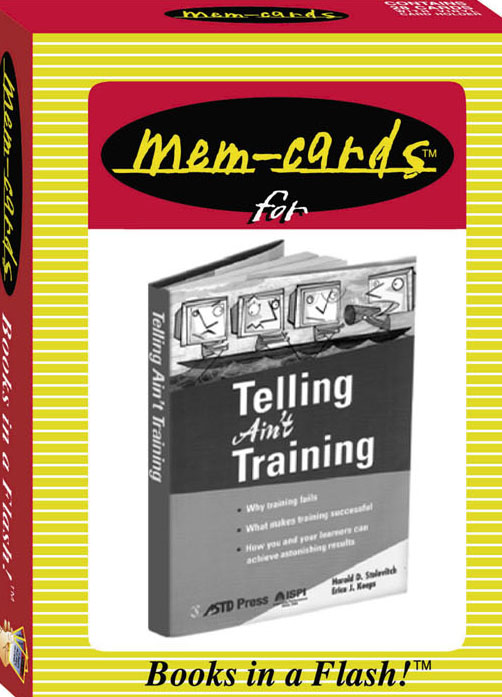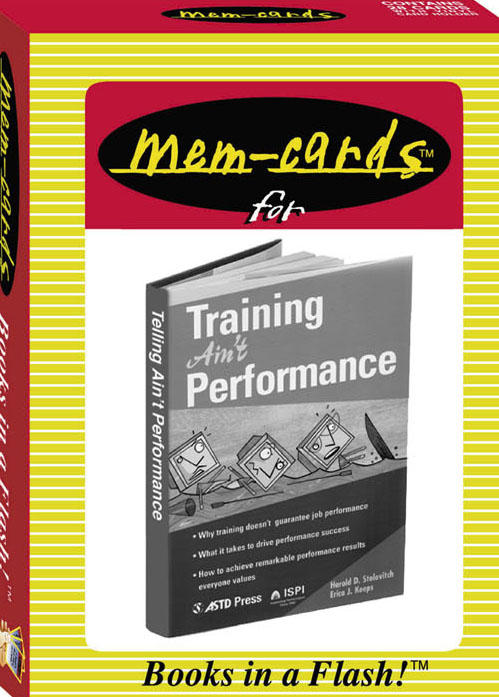![]()
By Harold D. Stolovitch & Erica J. Keeps
hstolovitch@hsa-lps.com & ekeeps@hsa-lps.com
 Before
embarking on a voyage to create instructional programs, it is essential
that one has an understanding of the learner population/s for which the
training is directed. This article provides guidelines and procedures
for conducting a Learner Analysis.
Before
embarking on a voyage to create instructional programs, it is essential
that one has an understanding of the learner population/s for which the
training is directed. This article provides guidelines and procedures
for conducting a Learner Analysis.
Who and How Many?
Here are some helpful guidelines for specifying what type of learners and what volume of learners you will train:
- Specify all of your target audiences. Notice the plural. Often, we receive a request for training (or generate a training initiative ourselves) that is focused on a single, specific audience (for example, sales representatives for Sales Force 12; customer service agents; installation technicians) as if it were completely homogeneous. Dig more deeply. Are we talking about novice or experienced workers? All levels of experience? Is what we will be developing only applicable to this specific group or can it (will it) be used with other groups (such as supervisors of the targeted group; part-time people who are also occasionally required to perform the same task; external, third-party partners)? Probe to identify all relevant learner groups and list these.
- For each group,
note their job titles and any major characteristics that will significantly
influence the way instruction will be received. Here are some examples
of such characteristics:
- English is a second language for 90 percent of the learners.
- This is a first full-time job for 80 percent of the learners.
- All of the learners have performed similar work for at least five years.
- The learners are 100 percent on sales commission.
- All learners are former bus drivers who, because of medical conditions, can no longer drive buses and now are forced to perform clerical jobs until retirement (to obtain full pension). They feel they have been demoted.
- The learners are from the top 10 percent of prestigious university MBA programs.
When you specify these major characteristics, you are signaling that they will have an important influence on learning.
- Specify volume or annual throughput. It is important to know the numbers as this can play an important role in how you choose to deliver the training and how much investment in training development is appropriate as that figure may not be acceptable unless the return on investment is expected to be very significant.
- Note geographic dispersion of the learner groups. This, too, will influence how you deal with training delivery decisions. It may be more cost effective to send a trainer to four sites than to incur additional costs to create Web-based learning.
Procedures for Conducting a Learner Analysis
The most common methods
for conducting learner analyses are these:
- For each identified target audience, select a sample of learners (more on this to follow).
- Obtain permission from managers (and from unions, if appropriate) to observe, interview and/or test the sample learners. By far, the most common technique for gathering information from learners is the structured interviews. Observation and performance testing can be very helpful in building a complete portrait of the learners, but these generally take large amounts of time and can be viewed as intimidating.
- Gather any existing
data that are available about each learner group. Examples of existing
data include:
- employment statistics (for example, years of experience, previous types of jobs, numbers of learners per geographic location)
- educational background (for example, schooling, previous training, certifications)
- work statistics (for example, performance results such as sales or average number of repair orders completed, ratio of exemplary performers to average and deficient performers)
- types and volume of grievances
- job descriptions or work expectations
- overall or synthesis reports of performance appraisals
- work climate
study reports.
- Interview sample learners and take careful notes on responses. Watch out for biases you may bring to the interviews.
- Synthesize the learner-analysis data in a succinct, accurate report.
- Use the findings of your learner analysis as key inputs to your training design. Respect who and what your learners are. Do not be overly influenced by what their managers tell you about them. Just because a manager used to be one of them does not mean she or he can speak for them. After all, weren't you once a teenager? Does this make you qualified to speak for your own teenage children or those of your neighbors?
Guidelines for Selecting Sample Learners
There are two main
guidelines for selecting sample learners for your learner analysis.
- Select, at random,
typical learners. They should not be the best or the worst. Absolutely,
positively and in no way (is that strong enough?) accept the following
as representing the learners you are targeting for your training:
- managers or supervisors who volunteer to "tell you about the learners because I work with them every day"
- instructors who offer to "tell you all about the learners because I teach them all the time"
- the best, most experienced performers
- those who have already taken the training (although these may be helpful for reviewing your training when you have tried it out)
- other instructional designers or trainers who will be happy to "speak from their experience with other groups"
- even truly
representative learners who volunteer to tell you about other learners
(let them speak only for themselves).
- For each target audience you simply require a few learners, often not more than four to six. Here is why. If you adopt what is commonly called a clinical approach, you probe, in-depth, with each individual subject - listening, observing and, if necessary, testing. You gain rapid insights about your learners. What our research shows in terms of quantity/usefulness of learner-analysis input is that after very few clinical instances, you obtain most of the required learner information for developing learner-centered training. Figure 1 shows what happens.
Figure
1: Quality and Usefulness of Learner Information Relative
to the Number of Learners Consulted

Determine how many different audiences you have (for example, novice/experienced/advanced; different job titles; different organizational levels) and consult learners, one at a time, until you do not appear to be accumulating significantly new and different information from additional subjects.
A Tool for Choosing What Information to Gather
The information you
should collect during your learner analysis is listed below.
- Target population
information:
- primary populations, including job titles and organization levels, and key or major characteristics of each
- secondary populations,
including job titles and organization levels, and key or major characteristics
of each.
- Background and
aptitude information:
- current knowledge and skills in the task or subject-matter area
- relevant background (for example, education, certifications) and experience
- understanding of the learning/performance required
- major misconceptions about the task or subject matter
- specific and
relevant background, experience and/or aptitude deficiencies that
might affect learning and/or performance.
- Attitudes information:
- general attitudes toward task or subject-matter content
- subtasks or subtopics within the task or subject-matter content toward which there are very positive feelings
- subtasks or
subtopics within the tasks or subject-matter content toward which
there are very negative feelings.
- Learning method
and language preferences information:
- instructional methods and strategies that are seen to facilitate learning (preferences)
- instructional methods and strategies that are seen to hinder learning (dislikes)
- instructional media/delivery systems preferences
- instructional media/delivery systems dislikes
- language level and knowledge of specialized terminology
- style of language
preferences (technical, conversational, combined).
- Tool and prerequisite
skills information:
- capabilities in relevant tools and prerequisite skills
- deficiencies in relevant tools and prerequisite skills
- other deficiencies
that require special attention.
- Other relevant
information about the learners:
- as a whole
- as specific populations or sub-groups.
By incorporating the
guidelines provided for specifying your learner populations and selecting
sample learners following the procedures given for conducting a Learner
Analysis and gathering the information listed above, you should be well
on your way to performing a Learner Analysis that will assist dramatically
in maintaining a learner-centered focus in your instructional design.
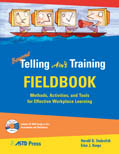
This article is an excerpt from Harold Stolovitch and Erica Keeps' bestseller,
Beyond Telling Ain't Training Fieldbook.
Interested in learning more? Click here
to order a copy of the book.
![]()
 Talent
Management is a monthly magazine directed to top-level management,
senior human resources, and workforce and organizational development executives
whose task is to optimize the abilities of their human assets to drive
and improve the execution of enterprise strategy. Harold Stolovitch is
the regular "Human Performance" columnist for Talent Management
magazine. You can read his latest article, "What To Do About Performance
Troublemakers " by
visiting page 10 of the October 2008 digtial edition at http://www.nxtbook.com/nxtbooks/mediatec/tm1008/.
For more information on Talent Management, visit their Website
at www.talentmgt.com.
If there are any topics that you would like Harold to address in his column,
please email him at hstolovitch@hsa-lps.com.
Talent
Management is a monthly magazine directed to top-level management,
senior human resources, and workforce and organizational development executives
whose task is to optimize the abilities of their human assets to drive
and improve the execution of enterprise strategy. Harold Stolovitch is
the regular "Human Performance" columnist for Talent Management
magazine. You can read his latest article, "What To Do About Performance
Troublemakers " by
visiting page 10 of the October 2008 digtial edition at http://www.nxtbook.com/nxtbooks/mediatec/tm1008/.
For more information on Talent Management, visit their Website
at www.talentmgt.com.
If there are any topics that you would like Harold to address in his column,
please email him at hstolovitch@hsa-lps.com.
![]()
Our Guest Author Series
features articles by various professional colleagues. The latest in our
series is by Carol Haig, CPT. Carol leads Carol Haig & Associates,
a consulting firm that helps organizations improve performance by aligning
the work, the worker and the workplace to meet business goals. To learn
more about her work, contact Carol by telephone at 925- 934-5338 or by
email at carolhaig@earthlink.net,
or visit her website at http://home.mindspring.com/~carolhaig.
Needs Analysis Can Save Your Life
By Carol Haig, CPT
 What
if you had just five minutes to conduct a needs analysis? And, you had
to do it over the phone, without observing the environment or anyone in
it? Oh, and you had to build rapport and trust while simultaneously entering
the information you gathered into an electronic call record? And you had
to do this for four consecutive hours? Every week!
What
if you had just five minutes to conduct a needs analysis? And, you had
to do it over the phone, without observing the environment or anyone in
it? Oh, and you had to build rapport and trust while simultaneously entering
the information you gathered into an electronic call record? And you had
to do this for four consecutive hours? Every week!
The Setting
Welcome to a community crisis center where trained volunteers answer the phones 24/7, fielding requests for help and information from a cross-section of county residents. Supported by an extensive resource database, knowledgeable staff, colleagues, and their own life skills and experience, volunteers have to be ready for anything. Indeed, calls can be about whatever is troubling the caller-from questions about local government services to requests for rental assistance, drug abuse treatment, counseling services and homeless shelters…to help with bereavement issues, mental illness, and suicide. Sometimes, the caller just needs to talk.
The Challenge
Most calls last less than 20 minutes, which means that the volunteer conducts a needs analysis at light speed. Like the analysis challenge in the workplace, ensuring that all needs are identified is the goal. However, because a life may be at risk, it is critical not to miss anything. The caller may be distressed, confused, disorganized, in danger, or unable to articulate a clear problem or request for help.
In addition, callers may not be native speakers of English, lack basic communication skills, and may be drunk, on drugs, or belligerent. They can be of any age. Often, their experiences in the world and their views of society differ greatly from those of the volunteer on the phone. To bridge the divide and help the caller, a solid grounding in the skills we use for a workplace needs analysis is an invaluable bonus for the volunteer. It is a small, but rather dramatic, step from the corporate client who is reluctant to spend time on analysis to the time crunch that comes with every hotline call.
Communication Protocol
Fortunately, the hotline environment encourages the jettisoning of politically correct (PC) business interaction. While initially uncomfortable, volunteers quickly learn to appreciate the license to ask all the highly non-PC questions they could never consider in the workplace: "What is the source of your income?" "And exactly what drugs are you addicted to?" "Do all six of your children have different fathers?" While it is important to gather critical information to help the caller, it is equally important to be respectful when asking questions. The combination of non-PC questions and the requisite follow-on inquiries move the analysis ahead quickly.
A real eye-opener in crisis work is that the majority of callers, particularly the regulars who phone in daily and have done so for years, struggle with multiple issues. No one, it seems, is "just" bi-polar, or obese, or unemployed, or living on the streets; they are likely to be facing a combination or even all of these challenges. So how are callers helped?
Toward Solutions
As we know from our experiences with workplace needs analyses, helping the client organize all the issues and then deciding which one(s) to address for the biggest potential payoff, is often the best course of action. On the hotline, volunteers apply a triage technique to help callers decide how to leverage their most critical issue(s) for results likely to mitigate some or all of the other concerns. Referring the caller to a full-service homeless shelter that provides counseling, health, and employment support, for example, could be the most effective overall solution.
The mission of a crisis center is to save lives and keep people safe. Suicidal callers often receive the greatest benefit from respectful but direct probing into their circumstances: "You say you want to kill yourself. Do you have a plan?" "Have you attempted suicide in the past?" "What happened?" "Have you ever been diagnosed with depression or a mental illness?" "Where are you right now?" With critical information collected through careful questioning, the volunteer can usually help the suicidal caller to identify a reason to continue living and formulate a strategy for both short and long-term survival.
Value Added
Needs analysis is
the responsibility of everyone in a leadership role; it is not the exclusive
territory of the performance improvement practitioner. Leaders conduct
needs analyses and choose solutions every day. From responding to a massive
disaster like September 11, to helping one caller on a crisis hotline,
needs analysis skills are invaluable. Where can you put yours to work?
We're always looking for articles to include in our Guest Author Series. If you have one that you would like us to consider, whether it be new or previously published, please contact Erica Keeps at ekeeps@hsa-lps.com.
![]()
By Erica J. Keeps
ekeeps@hsa-lps.com
 Recently
back from our latest river cruise through Provence (this one makes three
in Europe in less than a year!), we realized that cruising is becoming
addictive! What could be more pleasant than cruising along in your floating
hotel exploring new places with old friends and new. Our latest voyage
was with Amadeus Waterways, specialists in river cruising in Europe. We
embarked in Lyon, France and disembarked in Arles, France seven days later.
Recently
back from our latest river cruise through Provence (this one makes three
in Europe in less than a year!), we realized that cruising is becoming
addictive! What could be more pleasant than cruising along in your floating
hotel exploring new places with old friends and new. Our latest voyage
was with Amadeus Waterways, specialists in river cruising in Europe. We
embarked in Lyon, France and disembarked in Arles, France seven days later.
 Cruising
is a time to unwind and enjoy not working; admire the countryside and
calm and serene rivers. Traveling through the wine county requires tasting
its products and learning about the viniculture that has been an occupation
and tradition for thousands of years. How civilized and pleasant to sip
a glass of Chateauneuf-du-Pape as you take the opportunity to meditate
on past activities while making resolutions for the future. How wonderful
it is to relax with friends and colleagues and discuss topics and themes
that we rarely have time to consider because of all the "fire fighting"
we are subjected to daily. All in all, a combination of personal and professional
renewal.
Cruising
is a time to unwind and enjoy not working; admire the countryside and
calm and serene rivers. Traveling through the wine county requires tasting
its products and learning about the viniculture that has been an occupation
and tradition for thousands of years. How civilized and pleasant to sip
a glass of Chateauneuf-du-Pape as you take the opportunity to meditate
on past activities while making resolutions for the future. How wonderful
it is to relax with friends and colleagues and discuss topics and themes
that we rarely have time to consider because of all the "fire fighting"
we are subjected to daily. All in all, a combination of personal and professional
renewal.

And now for a change of pace! Our next cruising adventure is an ocean
cruise on one of the largest ships in the world. We board our ship, Royal
Caribbean Cruise Line's Mariner of the Seas, in Los Angeles on February
22, 2009 and return seven days later after visits to three ports on the
Mexican Riviera and several days at sea. Interested in joining us, contact
me by email at ekeeps@hsa-lps.com
or by phone at 310-286-2722.
![]()
Harold Stolovitch will present Training Ain't Performance on October 16, 2008 and conduct his Systematic Course Development Workshop from November 18 - 20, 2008 for the ASTD Los Angeles Chapter in Los Angeles, CA. Click here to view HSA's Events Calendar to learn where and when Harold will be speaking as well as to read session descriptions.
 Due to popular demand, Harold will be the principal speaker and facilitator
at ASTD's Telling Ain't Training Mini-Conference on October 21 & 22
in Chicago, IL and on November 6 & 7 in Arlington, VA. Click here
for more information.
Due to popular demand, Harold will be the principal speaker and facilitator
at ASTD's Telling Ain't Training Mini-Conference on October 21 & 22
in Chicago, IL and on November 6 & 7 in Arlington, VA. Click here
for more information.
![]()
 Do
you have any burning Human Performance Technology questions? Visit the
Ask Harold section of HSA's Website
and ask your questions for Harold Stolovitch to answer. Here is a recent
submission that might intrigue you:
Do
you have any burning Human Performance Technology questions? Visit the
Ask Harold section of HSA's Website
and ask your questions for Harold Stolovitch to answer. Here is a recent
submission that might intrigue you:
What
is the difference between a competency and a skill?
To read
the response, visit Ask
Harold. To ask your own question, just click on the crystal
ball at left, fill out the form and click submit.
![]()
Click on any of the covers below for more information or to purchase copies of our books and learning aids.
For more information on HSA, visit our Website
at www.hsa-lps.com, email us at info@hsa-lps.com
or call us toll free at 1-888-834-9928.If you have any questions or comments, please feel free to contact Samantha Greenhill, Publications and Communications Specialist, at sgreenhill@hsa-lps.com.
To unsubscribe from this Newswire, please reply to this email and put the word UNSUBSCRIBE in the subject line.
© Copyright 2008 Harold D. Stolovitch & Erica J. Keeps
